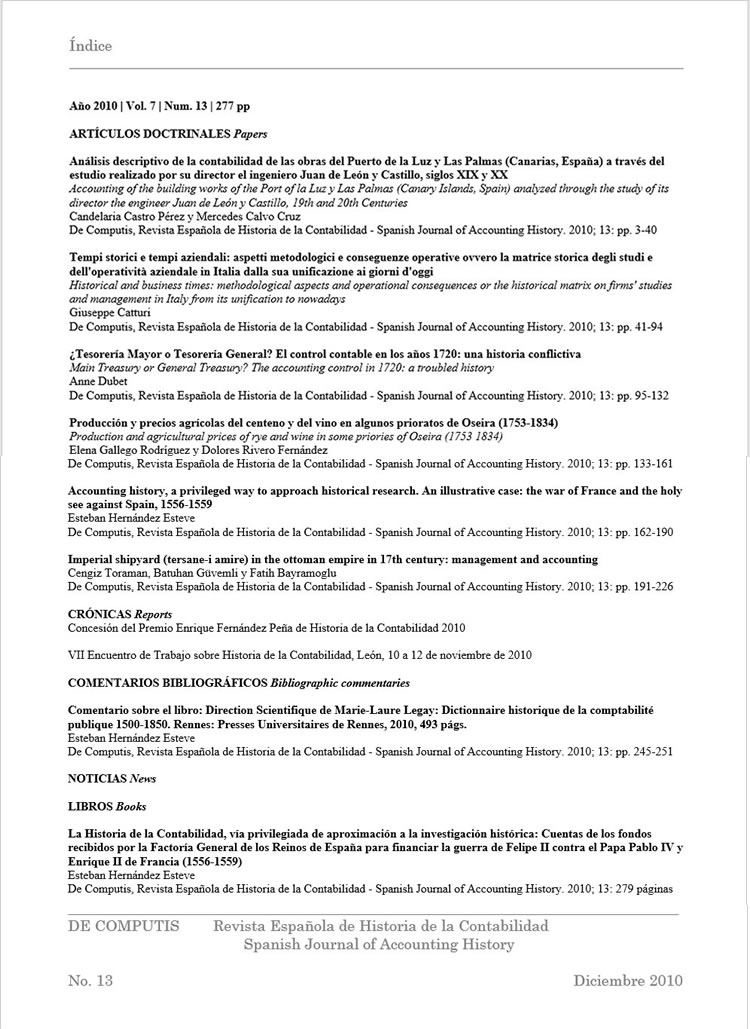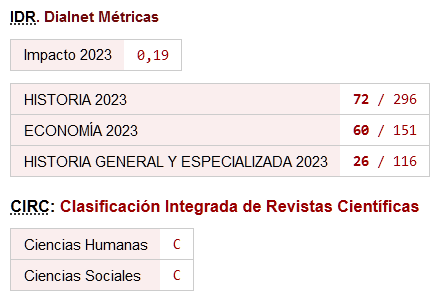Imperial shipyard (tersane-i amire) in the ottoman empire in 17th century
management and accounting
DOI:
https://doi.org/10.26784/issn.1886-1881.v7i13.119Palabras clave:
Ottoman Empire, 17th Century, Shipyard Administration, Accounting HistoryResumen
The institutions of the Ottoman Empire were under state control. The Imperial Shipyard (Tersane-i Amire) was amongst them. The Imperial Shipyard was established at the end of the 15th century in the Golden Horn (Haliç) - Istanbul and today it continues to operate. This study examines the management and the accounting infrastructure of the shipyard in order to understand the reasons for the mutual interaction between the management and accounting practices of the Ottoman Empire. Thus, this study provides a framework for the state accounting practices of the Ottoman Empire by examining an accounting document regarding the Imperial Shipyard in the year 1661 A.D. (Hegira 1071-1072). Evaluation of the documents indicates that accounting has the ability to meet the needs of the sector which it services. But the concept of cost is not developed within the regarding era.
Descargas
Citas
Ana Britannica (1986). Vol. 3. Istanbul.
Ana Britannica (1988) Vol. 12. Istanbul.
Bostan, I. (2007) "Ottoman Maritime Arsenals and Shipbuilding Technology in the 16th and 17th Centuries" Foundation for Science Technology and Civilisation, January.
Bostan, I. (1992) Ottoman Navy Organisation: Grand Shipyard in XVII. Century. Ankara. Turkey.
Develioglu, F. (1998) Ottoman - Turkish encyclopedic dictionary, 15.ed. Istanbul. Turkey.
Güvemli, O. (2000) Türk Devletleri Muhasebe Tarihi Osmanli Dönemi Tanzimat'a Kadar (Accounting History of the Turkish States Ottoman period - Until Reformation). Vol. 2. 2. Ed. Istanbul. Turkey.
Güvemli, B., Yilmaz, N., Çekici M. (2008) A Practical Application Of The Ladder Method: Muqata'ah Accounting. Proceedings of the 12th World Congress of Accounting Historians. Vol.II. Istanbul, Turkey. p. 1827-1853.
Güvemli, O., Erkan, M., Elitas C., Aydemir O., Oguz O. (2008) Accounting Method Used by Ottomans For 500 years : Stairs ( Merdiban) Method. 2008. Ankara. Turkey.
Güvemli O. and Güvemli B. (2007) The Birth and Develeopment of an Accounting Method in the Middle East (Merdiban Method), The Fifth Accounting History International Conference, Banff - Canada. August 9-11.
Güvemli O. and Gücenme Ü. (2002) The Government Accounting Profession During the Ottonan Empire - Hazine-i Amire (1470-1839). IX. Congress of World Accounting Historians. Melbourne - Australia.
Güvemli O. and Toraman C. (2004) The State Accounting System Used in The Otaman Empire : An Example of Transportation Accounting. X. World Congress of Accounting Historians, St. Louis USA.
Toraman C., Yilmaz S., Bayramoglu F. (2005) Estate Accounting as a Public Policy Tool and Application in the Otoman Empire in the 17 th Century. Academy of Accounting Historians Research Conference October 6-8. ColumbusUSA . https://doi.org/10.26784/issn.1886-1881.v3i4.205
Karamursel, Ziya. (1940). Surveys Regarding Ottoman Financial History. Ankara. Turkey.
Özveren E. and Yildirim O. (2006) Procurement Of Naval Supplies During The Sixteenth Century: Venetian Arsenale And The Ottoman Tersane Compared, 2nd MMHN Conference. Messina/Taormina. Italy.
Prime Ministry Ottoman Archives: Grand Shipyard production books registered under MAD 852.
Prime Ministry Ottoman Archives MAD: 7458, 5787, 5024, 979, 5932, 996, KK.5657.
Prime Ministry Ottoman Archive Number MAD 966
Prime Ministry Ottoman Archives KK 2623, KK 5655.
Prime Ministry Ottoman Archives MAD 2787 and MD CIII.
Uzunçarsili I.H. (1948) Centre and Naval Organisation in the Ottoman State. Ankara. Turkey. Ünver A.S. An annex to the Emperor at the end of XVII. Century, Belleten Journal, XXXIII.
Descargas
Publicado
Cómo citar
Número
Sección
Licencia

Esta obra está bajo una licencia internacional Creative Commons Atribución-NoComercial-CompartirIgual 4.0.










